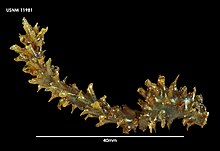| Pterobranchia Temporal range:
| |
|---|---|

| |
| Cephalodiscus nigrescens (collected from the Weddell Sea) | |
| Scientific classification | |
| Domain: | Eukaryota |
| Kingdom: | Animalia |
| Phylum: | Hemichordata |
| Class: | Pterobranchia Lankester 1877 |
| Orders | |
| Synonyms | |
| |
Pterobranchia, members of which are often called pterobranchs, is a class of small worm-shaped animals. They belong to the Hemichordata, and live in secreted tubes on the ocean floor. Pterobranchia feed by filtering plankton out of the water with the help of cilia attached to tentacles. There are about 25 known living pterobranch species in three genera, which are Rhabdopleura, Cephalodiscus, and Atubaria. On the other hand, there are several hundred extinct genera, some of which date from the Cambrian Period.
The class Pterobranchia was established by Ray Lankester in 1877. It contained, at that time, the single genus Rhabdopleura. Rhabdopleura was at first regarded as an aberrant polyzoon, but when the Challenger report on Cephalodiscus was published in 1887, it became clear that Cephalodiscus, the second genus now included in the order, had affinities with the Enteropneusta.
Electron microscope studies have suggested that pterobranchs belong to the same clade as the extinct graptolites,[1][2] and phylogenetic analysis suggests that the pterobranchs are living members of the graptolite clade.[3][4]
- ^ Sato, A; Rickards RB; Holland PWH (2008). "The origins of graptolites and other pterobranchs: a journey from 'Polyzoa'". Lethaia. 41 (4): 303–316. doi:10.1111/j.1502-3931.2008.00123.x.
- ^ Fortey, Richard A. (1998). Life: A Natural History of the First Four Billion Years of Life on Earth. New York: Alfred A. Knopf. p. 129. ISBN 978-0-375-40119-0.
- ^ Mitchell, C. E.; Melchin, M. J.; Cameron, C. B.; Maletz, J. R. (2012). "Phylogenetic analysis reveals that Rhabdopleura is an extant graptolite". Lethaia. 46: 34–56. doi:10.1111/j.1502-3931.2012.00319.x.
- ^ Maletz, Jörg (2014). "The classification of the Pterobranchia (Cephalodiscida and Graptolithina)". Bulletin of Geosciences. 89 (3): 477–540. doi:10.3140/bull.geosci.1465. ISSN 1214-1119.